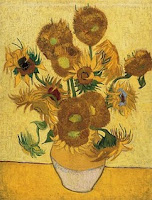Skip to comments.
Copying Sunflowers
Kitchen Table Math ^
| Saturday April, 7 2007
| Becky C
Posted on 04/08/2007 8:47:47 AM PDT by Eepsy
 I have been reading up on Vincent Van Gogh to prepare to give a short Art Literacy lesson at my children's school. I will read from a script, but I do a better job if I have read more than the script, beforehand.
I have been reading up on Vincent Van Gogh to prepare to give a short Art Literacy lesson at my children's school. I will read from a script, but I do a better job if I have read more than the script, beforehand.
The constructivist ethos of our Art Literacy program is to give children as much freedom as possible in achieving the production goal that follows each lesson. In this case, the goal for each child will be to paint a sunflower and show its texture by using specially thickened paint and a palette knife. Vincent used a lot of paint on his canvases.
In art, as in learning to read words or to add numbers, constructivists do not want children copying someone else’s good idea, whether it's how to paint a sunflower or how to sound out a word or how to add two numbers by counting-on. The child who copies is the child of a lesser god. He has fallen short of the goal of constructing original aesthetic or literary or mathematical meanings.
So I will read the Van Gogh lesson script and assign the painting, but I'm not supposed to finish what I've started by leading the children step by step through one method of creating one copy of one of Vincent's sunflowers. I show them one sunflower, and then let them learn the rest by doing it themselves as best they can. Once. Because they won't get a second chance because there isn't time.
They must copy one of Vincent's sunflowers, but I can't teach them how to use the tools they are given to achieve an aesthetic meaning that would be mine and not their own. I would be putting words in their mouths, so to speak, if I led them.
I was amused to read letters that Vincent wrote to his brother Theo and find that Vincent was often quite skeptical of his fellow artists and their methods. Among other observations, here is one excerpt from a letter he wrote from St. Remy on the subject of copying another artist’s work:
 It is a kind of study that I need, for I want to learn. Although copying may be the old system, that makes absolutely no difference to me. [I have copied the Pieta and] I am going to copy the Good Samaritan by Delacroix too. What I am seeking in it and why it seems good to me to copy them I will tell you - they are always asking we painters to compose ourselves and be nothing but composers. So be it - but it isn't like that in music - and if some person plays Beethoven, he adds his personal interpretation - in music and more especially in singing - the interpretation of a composer is something, and it is not a hard and fast rule that only the composer should play his own composition.
It is a kind of study that I need, for I want to learn. Although copying may be the old system, that makes absolutely no difference to me. [I have copied the Pieta and] I am going to copy the Good Samaritan by Delacroix too. What I am seeking in it and why it seems good to me to copy them I will tell you - they are always asking we painters to compose ourselves and be nothing but composers. So be it - but it isn't like that in music - and if some person plays Beethoven, he adds his personal interpretation - in music and more especially in singing - the interpretation of a composer is something, and it is not a hard and fast rule that only the composer should play his own composition. .jpg) Very good - and I, mostly because I am ill at present, I am trying to do something to console myself for my own pleasure. I put the black and white [Pieta] by Delacroix… in front of me as a subject - and then I improvise colour on it, not, you understand, altogether by myself, but searching for memories of their pictures - but the memory, the vague consonance of colours which are at least right in feeling - that is my own interpretation.
Very good - and I, mostly because I am ill at present, I am trying to do something to console myself for my own pleasure. I put the black and white [Pieta] by Delacroix… in front of me as a subject - and then I improvise colour on it, not, you understand, altogether by myself, but searching for memories of their pictures - but the memory, the vague consonance of colours which are at least right in feeling - that is my own interpretation.
Many people do not copy, many others do - I started on it accidentally, and I find that it teaches me, and above all it sometimes consoles me.
I am sorry he was not consoled more, sooner.
During the Art Literacy lesson we are to tackle the subject of Vincent’s mental illness right out of the box because even the littlest kids already know that he cut off his ear, and we need to manage their interpretation of the event.
We can also say that Theo sent Vincent money to keep him alive and painting, and we can say everybody is sad that Vincent never knew how famous his paintings would become.
But we don't tell the children that he made copies. Or that he took art lessons in Paris and he read books on technique that Theo bought for him. We don’t explain that Vincent made preparatory sketches and studies before he painted. We skip right over his many careful revisions, as he frequently returned to favorite subjects in favorite colors like sunflowers. We don't tell the children that, in his correspondence with Theo (who was working for an art dealer in Paris) the two of them were always desperately trying to figure out how to sell more of Vincent's paintings.
TOPICS: Arts/Photography; Education
KEYWORDS: vangogh
1
posted on
04/08/2007 8:47:48 AM PDT
by
Eepsy
To: Eepsy
Start by teaching them about Van Gogh’s mental illness? If you really want to screw them up, there is always Dali.
2
posted on
04/08/2007 8:51:08 AM PDT
by
NonValueAdded
(Prevent Glo-Ball Warming ... turn out the sun when not in use)
To: Eepsy
Only in academia do they want creativity. In business the worker is expected to do his/her job like they were taught. The last thing this society needs is a police man with creative ideas on how to punish people. Or a computer fabricator who just creatively connects wires. Or a farmer creatively fertilizing his fields.
.....Bob
3
posted on
04/08/2007 9:01:39 AM PDT
by
Lokibob
(Some people are like slinkys. Useless, but if you throw them down the stairs, you smile.)
To: Lokibob
Or a computer fabricator who just creatively connects wires. Creativity is very useful in electronics design, but it must not be an end in and of itself. If I think my circuit is beautiful and elegant, but the electrons have other ideas, my judgement must yield to theirs. On the other hand, if I can see a novel way of doing someething that will work adequately and yet be cheaper than the prevailing methods, I shouldn't dismiss it merely because it hasn't been done before.
Back in the heyday of the Atari 2600 Video Computer System, cartridges that needed more than the 4K of directly-addressable code needed some sort of bank-switching hardware. While some games used custom silicon to control banking, other games used a combination of three 74xx chips for the task. Rather than follow their model, I developed my own bank-switching method using a single 74LS153. Curious nobody did that 25 years ago, since the 74LS153 had been cheaply available for more than a decade (it's used in the original Pong). But I guess nobody had the idea.
4
posted on
04/08/2007 1:59:06 PM PDT
by
supercat
(Sony delenda est.)
To: Lokibob
“computer fabricator who just creatively connects wires”
Was on a few installations where this happened,thankfully no longer work for that outfit. LOL
5
posted on
04/09/2007 3:54:05 AM PDT
by
Nailbiter
To: Eepsy
Fascinating. I see this time and again in educational philosophy today — no history, no building skills upon skills. Why is it that we equate primitivism and ignorance with the creative impulse? Is this not a tyranny in itself? It’s anti-intellectual, promoting widespread ignorance rather than knowledge, and has the ironic effect of hindering the very creativity it purports to support.
Disclaimer:
Opinions posted on Free Republic are those of the individual
posters and do not necessarily represent the opinion of Free Republic or its
management. All materials posted herein are protected by copyright law and the
exemption for fair use of copyrighted works.
FreeRepublic.com is powered by software copyright 2000-2008 John Robinson
 I have been reading up on Vincent Van Gogh to prepare to give a short Art Literacy lesson at my children's school. I will read from a script, but I do a better job if I have read more than the script, beforehand.
I have been reading up on Vincent Van Gogh to prepare to give a short Art Literacy lesson at my children's school. I will read from a script, but I do a better job if I have read more than the script, beforehand.
.jpg)